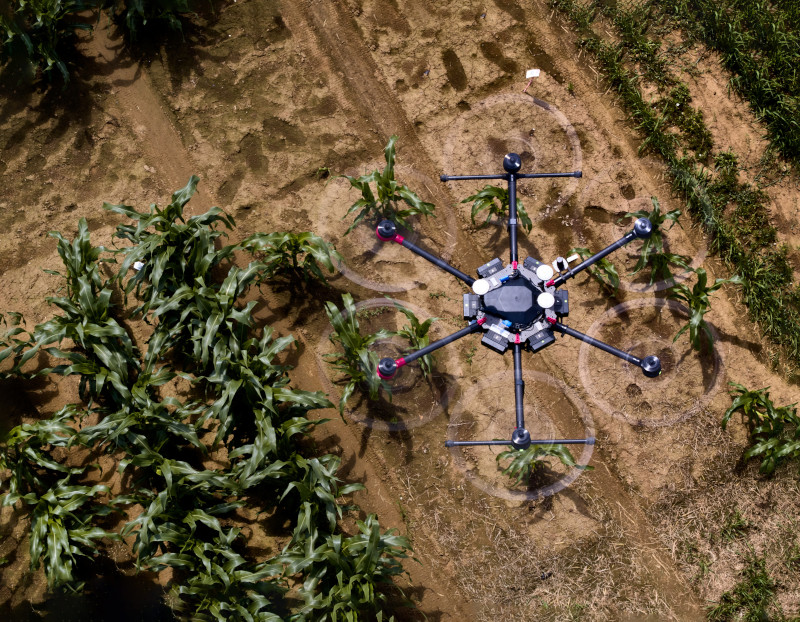Nichtinvasive Phänotypisierung mit autonomen Robotern
Dieser Use Case zeigt das Potenzial von multimodalen Datenanalysemethoden und Algorithmen des maschinellen Lernens für die Phänotypisierung von Pflanzen im Feld.
Partners:
Forschungszentrum Jülich (FZJ)
University of Bonn
Der Hintergrund

Eine nachhaltige Pflanzenproduktion erfordert Kenntnisse über den strukturellen und funktionellen Status der Pflanzen auf dem Feld, um präzise Feldmaßnahmen zu planen und durchzuführen. Anstelle einer häufigen Anwendung von Pestiziden oder Düngemitteln sollte beispielsweise ein pflanzenspezifischer Bedarf ermittelt werden, und die Maßnahmen sollten auf Pflanzenebene geplant und durchgeführt werden. Eine wichtige Frage der Agrarforschung ist, wie eine solche Steigerung der Präzision erreicht werden kann. Drohnen und Feldroboter in Kombination mit modernen Sensorsystemen und Kameras sind vielversprechende Instrumente, um bei Bedarf Echtzeitdaten zu Pflanzenmerkmalen zu liefern; so hat die Phänotypisierung von Pflanzen Eingang in die Pflanzenzüchtung und die moderne Landwirtschaft gefunden. Um komplexe Pflanzeneigenschaften wie Stressresistenz oder Krankheitsresistenz zu quantifizieren, sind Kombinationen aus mehrfacher nichtinvasiver Phänotypisierung mit Sensoren und fortschrittlichen Datenanalysemethoden und Algorithmen des maschinellen Lernens heute Stand der Technik. Obwohl in den letzten Jahren erhebliche Fortschritte in der Sensortechnologie, im maschinellen Lernen und in der autonomen Robotik erzielt wurden, stehen wir noch am Anfang, um das volle Potenzial dieser Daten auszuschöpfen. Eine mögliche Erweiterung der Analyse ist die Fusion und kombinierte Analyse von wiederholt erfassten Sensordaten mit Umweltdaten durch die Kombination von Informationen über Jahre hinweg, einschließlich Informationen über frühere Feldeinsätze. Ein weiterer relevanter Faktor ist die Integration der genetischen und biochemischen Merkmale verschiedener Pflanzentypen und Zuchtlinien. Darüber hinaus ist es noch eine offene Forschungsfrage, ob und wie solche autonomen Multisensor-Roboter entwickelt und im Feld eingesetzt werden können und wie Datenströme aus der Kombination von Sensoren und Algorithmen zusammengeführt werden können, um relevante Pflanzeneigenschaften zu identifizieren oder Stresssituationen frühzeitig zu erkennen.
Die Ziele
Das Hauptziel dieses UC ist es, das Potenzial einer FAIR-Dateninfrastruktur für die Entwicklung multimodaler Datenanalysemethoden und maschineller Lernalgorithmen für die Phänotypisierung von Pflanzen im Feld und die Agrarrobotik zu untersuchen und zu präsentieren. Insbesondere zielt diese UC darauf ab, die Anforderungen an die Datenkuratierungsdienste zu definieren. Dazu gehören automatisierte Werkzeuge zur Qualitätssicherung und Datenharmonisierung, die den Nutzen der Daten für kombinierte Analysen erhöhen. Die UC wird auch untersuchen, wie die in der Dateninfrastruktur gespeicherten Feldumgebungsdaten für Forscher visualisiert werden können, um sie bei der Bedienung von Multisensorsystemen oder der Steuerung von Agrarrobotern zu unterstützen (z. B. bei der Entscheidung, welche Feldarbeiten ein Roboter durchführen soll). Durch die Durchführung einer Pilotstudie wird diese UC als frühe Anwenderin der in FAIRagro entwickelten Dienste fungieren. Darüber hinaus arbeiten wir eng mit den Datenverwaltern zusammen, um die spezifischen Anforderungen an Phänotypdaten für die Verwendung im maschinellen Lernen aus diesem Anwendungsfall in die FAIRagro-Standards und -Richtlinien aufzunehmen und die Datenverwalter darüber zu informieren, wie sie weitere Datensätze entsprechend kuratieren können. Es bleibt eine wissenschaftliche Herausforderung, die Anforderungen von Experten für maschinelles Lernen mit dem Potenzial der Phänotypisierung im Feld in Einklang zu bringen. Während die Feldphänotypisierung eine riesige Menge an quantitativen Pflanzendaten liefert, fehlen möglicherweise noch wesentliche Informationen, um diese Daten für Ansätze des maschinellen Lernens nutzbar zu machen.
Die Massnahmen
- Entwicklung von RDM-Anforderungen für Feldphänotypisierungsdaten
- Erstellung und Freigabe eines Benchmark-Datensatzes mit vollständigen Feldphänotypisierungsdaten
- Pilotstudie mit Datenkuratierungs- und Visualisierungsdiensten

